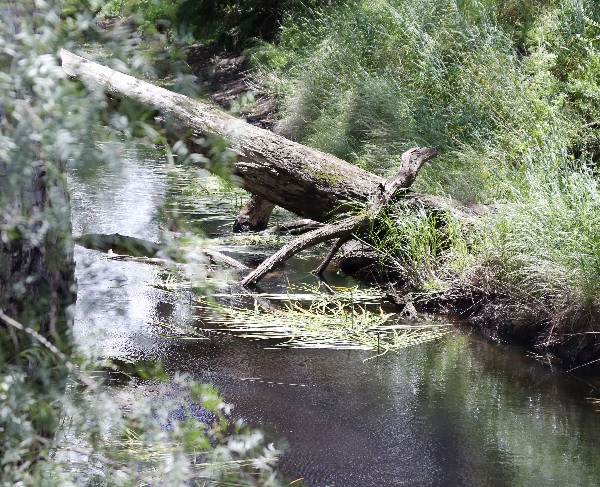
Preventing hypoxic blackwater events is an environmental watering objective in the Moorabool River.
Moorabool River streamside vegetation, by Sarah Martin, Corangamite CMA
When you hear about toxic blackwater events it’s often in conjunction with reports of severe fish deaths and floods. However, the truth about blackwater is more complex.
What is toxic blackwater?
Put simply, toxic blackwater is a term used when high levels of organic material and tannins in a river discolour the water making it appear black– like a really-strong pot of tea. It occurs when large amounts of organic material on floodplains are covered with water in warm conditions and large amounts of dissolved carbon get into the water. Bacteria multiply quickly to use the massive amounts of dissolved carbon (it’s a feeding frenzy), but in doing so the bacteria multiply and use up a lot of the oxygen in the water – oxygen that fish need. This is also called a hypoxic blackwater event.
This short video describes the cause and effect of blackwater, and how CMAs in northern Victoria work to help manage toxic blackwater: What is toxic blackwater?
The increase in large scale hypoxic blackwater events is due to a combination of the highly modified nature of our waterways and climate change. River regulation has contributed to the increase in the number of severe hypoxic blackwater events. Large dams capture almost all small to medium inflows in winter-spring. This means leaves, bark and other organic material builds-up on floodplains. Without frequent flooding (as they would have naturally without dams), floodplains build up too much leaf litter so that when they do flood, excessive amounts of organic material are dumped in the river system often creating hypoxic blackwater.
When large floods occur, more material (organic carbon) is flushed into rivers and if flooding coincides with warmer weather, hypoxic blackwater conditions can occur. Three key factors influence the severity of hypoxic blackwater events—the amount of plant material, air and water temperature and the time since overland flooding.
Floodplains need regular, frequent watering to disperse leaf litter in smaller manageable amounts. River regulation (supplying water to towns, industry and farms), and a warming climate characterised by longer dry periods, has reduced the long-term frequency of floodplain flooding.
Is blackwater always toxic?
No, it isn’t. In fact, blackwater can be quite beneficial. Blackwater is a natural part of the ecology of lowland river systems. It can provide a valuable source of carbon to rivers, which is ultimately turned into food for animals such as waterbugs, fish, frogs, birds, platypus and turtles. But in some cases, blackwater can reduce the amount of oxygen in the water, which is then harmful to fish and other aquatic species.
Not all blackwater events will reduce oxygen levels enough to harm fish or other aquatic animals. Blackwater events that lead to dangerously low oxygen levels are hypoxic blackwater.
Blackwater has always been a natural feature of lowland river systems and occurs during flooding when organic material is washed off the floodplain and into the rivers. Organic material entering the river from floodplains can be great for fish and other river organisms as it provides food and can assist in enabling important ecological processes (e.g. fish breeding).
How can water for the environment help?
Environmental water can be used as a preventative measure to help mitigate blackwater risks in certain areas. Targeted environmental watering can reduce the build-up of organic matter in some areas, lessening the frequency of blackwater events. This is like how planned burns can lessen the impact of bushfires.
Recreational angler Rohan Jenner, talks about the benefits of blackwater for fish and the broader environment, and how water for the environment can be used to prevent toxic blackwater: What is good blackwater?
Just as land managers carry out frequent cool burns to avoid one big hot, damaging bushfire, environmental water managers try to reduce excessive leaf litter build up on floodplains with regular flooding. This aims to reduce the risk of hypoxic blackwater events, while providing a boost to floodplain vegetation, and providing connectivity between the river and the floodplain to maintain productive foodwebs and support species that need access to both.
Most recently in northern Victoria, across the lower Loddon River, Serpentine Creek and Pyramid Creek, environmental flows were released to wash away leaf litter while the weather was still cool. Reducing leaf litter through targeted water releases in spring can reduce the risk of a hypoxic blackwater event if there is flooding during the summer months.
In this way, the limited resources of environmental water are better used to try to prevent hypoxic blackwater events and to help maintain healthy native fish and animal populations in waterways in good times, so that populations are able to bounce back when there are impacts.
In some systems, environmental flows can be provided at the right time and volume to assist in ‘freshening up’ a waterway during the warmer months and help mitigate the risk that stagnant pools will turn toxic during periods of low flows. Once a blackwater event has eventuated, there are limits on what environmental water can do to assist – it will depend on the scale of the event and the impacts, how much environmental water is available, consideration of other risks and alternative feasible management options. In many cases mitigation measures to resolve blackwater events are limited but water agencies will work together to determine if and when management options are available.